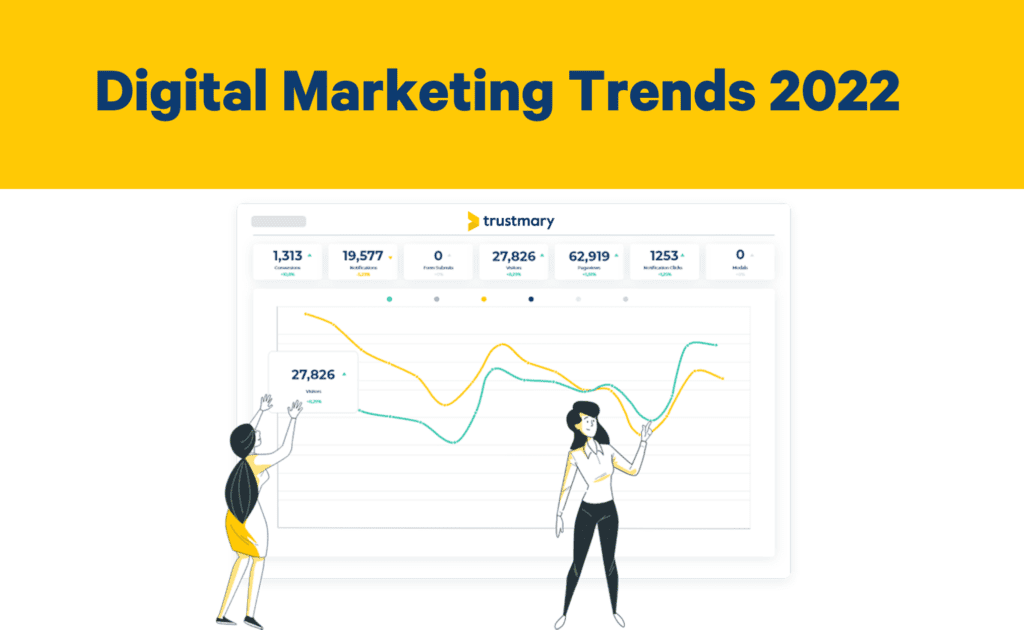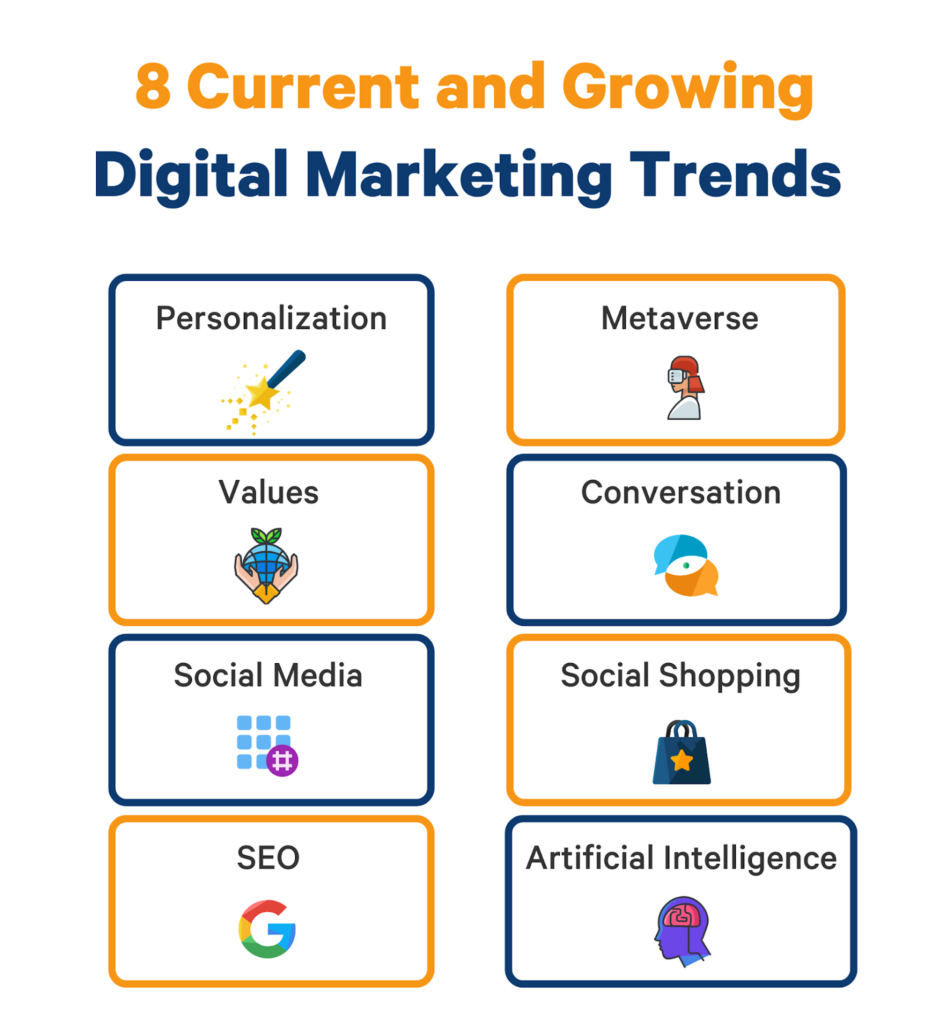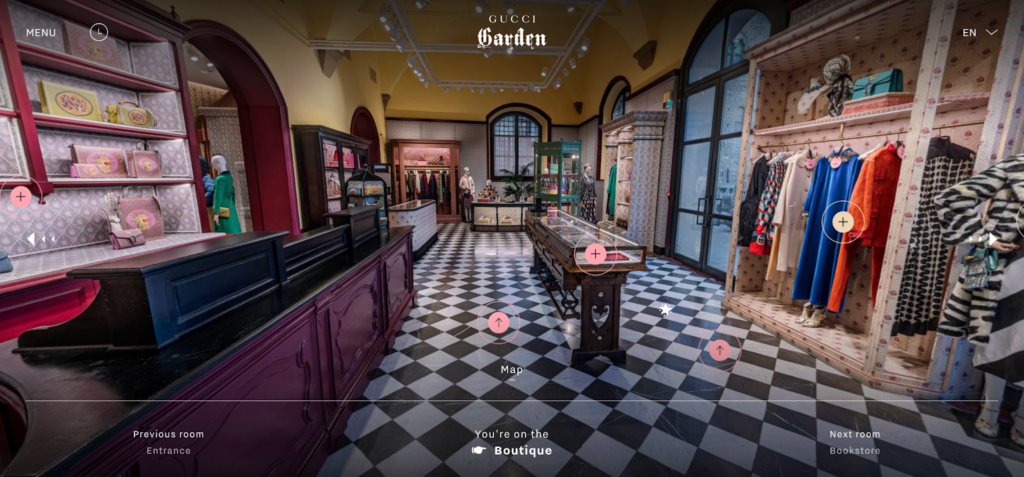Digital Marketing Trends 2024: The Rise of Artificial Intelligence

Understanding the digital marketing trends 2024 is an essential part of developing the best digital marketing strategy for the future.
Check out these digital marketing and artificial intelligence trends to gain a competitive advantage for your business.
In the end, we will also briefly look at the predictions for marketing in 2023 and 2024.
Top Digital Marketing Trends to Keep in Mind
The digital marketing industry is one of the fastest changing industries out there. Technological advancements get crazier every year, and the pandemic has accelerated the progress.
The younger generations are born with technology and digital devices, which means new challenges for digital marketers.
It is time to evaluate what digital marketing activities are a thing of the past and what marketing tools you should implement next.
Here are 8 current digital marketing trends that all digital marketers should take into account.

1. Increased Focus on Personalization
As competition continues to increase, businesses will need to find new ways to stand out from the crowd. One way to do this is to personalize the user experience.
This could include using data to deliver targeted content and ads, or tailoring the user journey to individual preferences.
Personalized marketing can also include personalized messaging in different channels, chat conversations, social commerce on social media platforms, and social shopping with other users.
More info about these marketing tactics will follow, so keep reading!
2. Content Marketing is Expanding to New Spaces
With the rise of metaverse and platforms that use augmented reality (AR) and virtual reality (VR), we’re seeing a shift towards more immersive content experiences.
Businesses will need to start thinking about how they can create engaging content that takes advantage of these new platforms.
This might seem very distant for most companies, especially for small businesses. But larger global brands are already taking advantage of the affordances of the metaverse.
For example, the luxury fashion brand Gucci has launched a virtual Gucci Garden tour, a digital replica of the actual museum in Italy. Users can browse the museum and request more information about the products.

The aim of such augmented reality platforms is to increase brand awareness especially among younger consumers who spend time gaming and are used to navigating in the digital world.
Considering the current pandemic, there are young people and children who are more used to the virtual world than actual public places. This is a significant future (and current) customer segment.
With the transfer to the metaverse comes the relevance of digital assets, non-fungible tokens (NFTs) and cryptocurrency. That's why crypto and NFT development are so popular now.
Another noteworthy trend to acknowledge is the continuing popularity of visual content and video marketing.
3. Greater Focus on Sustainability and Other Values
As consumers become more aware of the environmental impact of their purchases, businesses will have to accommodate it in order to maintain a good online reputation.
We can see this happening all over the garment industry, where more and more brands are implementing sustainable fashion policies as customers shift away from the fast fashion brands.
This affects more than just marketing. It requires action from all parts of the company. It can mean environmentally friendly packaging and overall more sustainable products and services.
Sustainability is not the only value that new generations expect to see from businesses: human rights, fair treatment of employees, inclusion and diversity, and general transparency of the company’s operations will affect purchase decisions in the future even more.
It is likely that consumers will also support brands that share the same core values.
What this means for marketers is that they have to highlight these aspects in marketing efforts. One cannot focus merely on marketing the products and services, but also on public relations and supporting good causes.
It is crucial to re-evaluate your marketing messages in the light of this information.
Pro tip: if you speak about social issues and sustainability, you need to live up to your own expectations. Greenwashing is so last season and brands’ lies will be exposed by the woke consumers.
I recommend you do actual good deeds and partner with other organizations!
4. Conversational Marketing
A 2021 report by Drift Insider found that customers expect better digital experiences, personalized content and instant responses to their question at all times. People are impatient and don’t want to spend time looking for information and navigating websites.
Answer to this problem is in conversational marketing. Its purpose is to engage customers with targeted messages and conversations.
Marketers have started contacting their customers e.g. on Facebook Messenger, WhatsApp or Slack. People also use Alexa and Siri to ask questions about brands.
Chatbots and live chats have a great role in conversational marketing. Chat is a way to stay in touch with customers 24/7 and make the experience more personal.
Especially AI-powered chatbots that use natural language processing and machine learning will become more and more popular during the years to come.
5. Social Commerce on New Social Media Platforms
Social commerce refers to the type of electronic commerce that happens in social media channels.
The social media users are able to communicate with the brand and other users, and make the purchases directly from the social media platforms they use the most.
Personally, I have done multiple purchases through Instagram and Facebook after seeing an advertisement.
Seems like I’m a prime example of a Millennial or Gen Z consumer: we are predicted to account for 62% of global social eCommerce revenue in 2025.
It is likely that shopping on social media platforms like TikTok, YouTube and Instagram will grow.
Another new phenomenon in the area is livestream shopping.
This is a way of shopping that combines e-commerce and entertainment. People are able to follow a real-time product demonstration on a social platform and interact with the host.
A livestream shopping experience provides the opportunity to communicate with the seller and ask questions about the product just like in a physical store. This often adds to the customer's confidence to buy a certain product.
If you use any social media platforms, it's likely you have encountered such an event. For example, TikTok is full of small business owners that organize "lives" to demonstrate their products and chat with people.
6. Social Shopping
A big part of social commerce is also social shopping, where the buyers’ friends are involved in the buyer’s journey. The process imitates the real-life situation of visiting the mall or farmer’s market, where people can talk about the products together with others and ask for advice.

Thus, influencer marketing and user generated content become even more important. People will rely on recommendations, reviews and testimonials from influencers as well as other regular consumers.
One way to leverage the phenomenon of social shopping is to apply reviews and testimonials from your happy customers to your website and social media channels.
That is easy to do with Trustmary. Start a free trial to test it out!
7. Time to Change Your SEO Strategy
Search engine optimization is important, especially what comes to visibility in Google.
If you reach the top search engine results pages, you can gain millions of views for your content.
However, it seems that organic search does not work as well as it used to. This means you might need to adopt other SEO tactics than before.
Try to hack the Google search results with these tips:
- Branded search: get your customers to use your brand name in their searches (which is easier said than done).
- Answer-based content: people use more and more voice search in the form of questions and you should try to answer them with your content.
- Audience research: who are your potential customers and what kind of problems they have that you can help with?
8. Marketing AI and Machine Learning
Artificial intelligence (AI) and machine learning are already being used in many aspects of digital marketing, from personalization to ad targeting.
In 2024, we expect to see even more businesses harnessing these technologies to drive better results.
Let’s take a closer look at AI trends in 2024.
You should also check out these AI tools to use in 2024.
Artificial Intelligence Trends 2024
1. Chatbots
Like mentioned before, conversational marketing is on the rise and chatbots have a big role in it.
While many of the current chatbots function based on scripted messages that you create beforehand, in the future more and more chatbots will be able to have natural-sounding conversations with users and learn from each interaction. The seamless functioning of chatbots is due to deep and supervised learning.
2. Voice Search
We briefly covered the issue of voice search and how it should affect your SEO and content marketing plan.
Let’s recap – instead of typing their google search, people use voice search to ask questions from search engines. Oftentimes these searches are more conversational queries, and you should be able to answer them in an equally conversational manner.
3. More Data and Better Analytics
There is more data available than ever before. It is not even possible for a human to manage and analyze such vast data without the help of a machine.
The best thing about AI-driven data analysis is that it can efficiently process data from various sources and angles through a well-optimized data pipeline. This way you can gain smart insights about your campaigns.
For example, Google Analytics has been using more machine learning already since 2020.
It also means that Reverse ETL is becoming more common for companies that have their data centralized in a warehouse and want to have metrics like daily active users, lifetime value, or customer acquisition costs at hand.
4. VR and AR
Virtual reality and augmented reality are growing, there’s no doubt about them being a great deal for digital marketers in the future.
But remember your target customers. It is not very likely that elderly people will buy your products with Bitcoin in the metaverse anytime soon.
However, there are generations that are already more used to the digital world than physical places like shopping centers.
It is a good time to start practicing leveraging VR now – it will be a huge advantage in a few years’ time.
5. Targeted Marketing with The Help of Predictive Analytics
Predictive analytics use algorithms, buyer intent, and other metrics to predict how your customers will behave and to divide them into different segments.
Knowing your customer’s next moves helps you generate targeted ads and content that converts well.
AI can also recommend relevant products and services to those who are most likely to be interested in them.
6. Personalized AI-Powered Content
AI is able to make content and send it to your target audience at the right time. This includes optimizing content for search engines, where AI for SEO can help improve rankings by tailoring content to user intent and boosting organic traffic.
Maybe in the future we will see more development in the sphere of visual AI generated content. For now, we have to mostly settle for written content.
Artificial intelligence can also help with personalization of the content, much like generating personalized recommendations.
7. Marketing Automations
Marketing automations help you to manage the campaigns across multiple channels, to define the best course of action, and send pre-scheduled campaigns and messages.
Artificial intelligence adds layers to your marketing automation and helps you to measure and analyze the success of your campaigns.
As AI becomes more integrated into business operations, companies must also ensure their automation processes are legally compliant. AI-powered contract review tools like LegalOn, can help organizations maintain compliance while scaling their digital marketing efforts.
Marketing teams will have less manual work and better understanding of the success of the campaigns with AI powered marketing automations.
8. Customer Relationship Management (CRM)
Different CRM companies are investing in AI.
In the near future, we will most likely see additional AI features in the customer relationship management systems like Pipedrive and Hubspot.
When the time comes, it helps companies to better manage their customer relationships, understand the customers, and keep track of interactions with customers even better.
The best thing: you save time and money!
AI Market Growth – Now Is the Time to Tap In!
When we speak about the AI market, we are speaking of a huge and rapidly growing business.
Gartner predicted in the autumn 2021, that worldwide AI software revenue would be $62.5 billion in 2022, growing by 21.3% from 2021. The fastest-growing segment would be knowledge management.
Statista forecast that the global AI software market revenue will reach $126 billion by 2025.
Investing or investment consultation is far out of my expertise, but even I can say that AI is worth checking out.
Predictions for Marketing in 2023 (to be updated)
It is likely that the above mentioned latest digital marketing trends keep growing in 2023 as well.
One big chance that will affect digital marketing in 2023 is saying goodbye to third party cookies.
While data collection and online privacy will become more secure, this will set challenges for marketers in the realms of personalization and targeted ads. New methods and marketing tactics have to be invented.
Additionally, we will in the near future likely experience a dramatic rise of marketing AI, changes in data privacy, and new SEO tactics.
The changes also affect your recruitment efforts: you need to acquire the best digital marketing talents to keep up with the future trends.
In order to attract the best talent, you not only need to offer a good salary and benefits, but also highlight the working conditions and great atmosphere of the company.
Trustmary’s tools let you do that. Collect written and video testimonials from your employees and attract the best talents! Start a free trial and see the best actionable tips and templates for employee testimonials.
FAQ
What are marketing trends?
The 2024 marketing trends, especially the digital marketing trends, include the growth of marketing AI, focus on personalization and values, new types of content marketing, the rise of metaverse and chatbots, new SEO tactics and increase in social media and social shopping.
How ai is reshaping marketing?
Artificial intelligence (AI) offers many new tools for marketers. They ease the personalization of your content, targeting the right messages to the right audiences, they save you time by creating content and marketing automations, they use machine learning and improve algorithms continuously. AI will shape the world in general, so it is only natural that digital marketing trends follow the progress.
How much is AI worth?
It has been predicted that worldwide AI software revenue would be worth $62.5 billion in 2022. The market is expected to grow tremendously during the next few years, up to $126 billion by 2025. That’s over 200% of the current worth!
